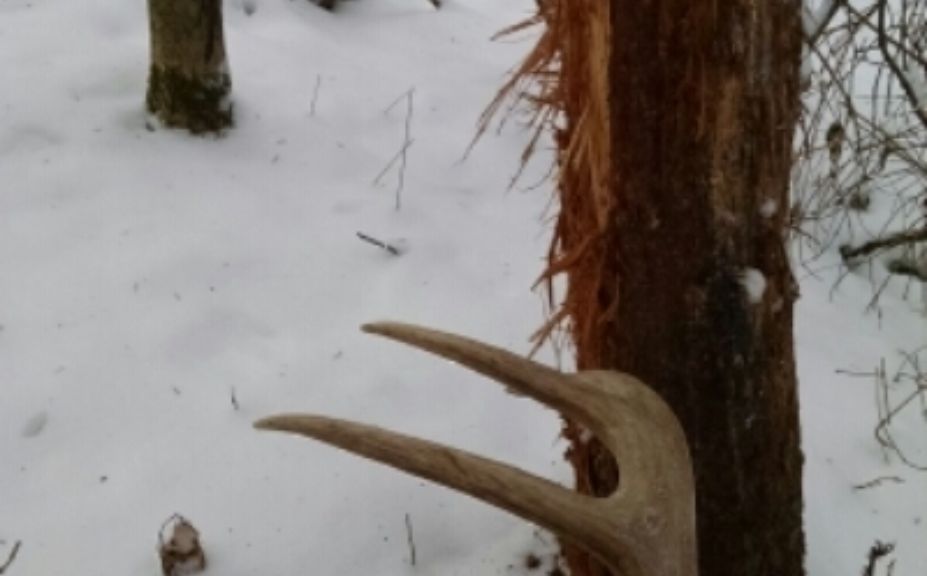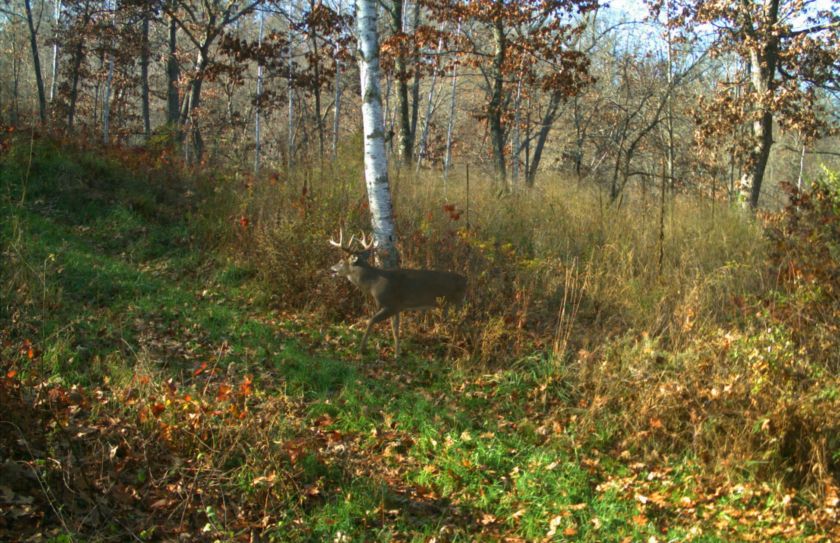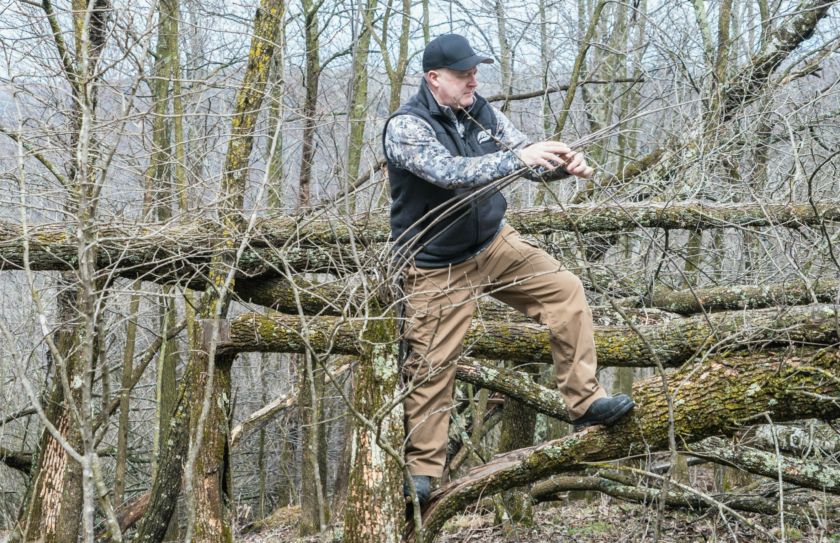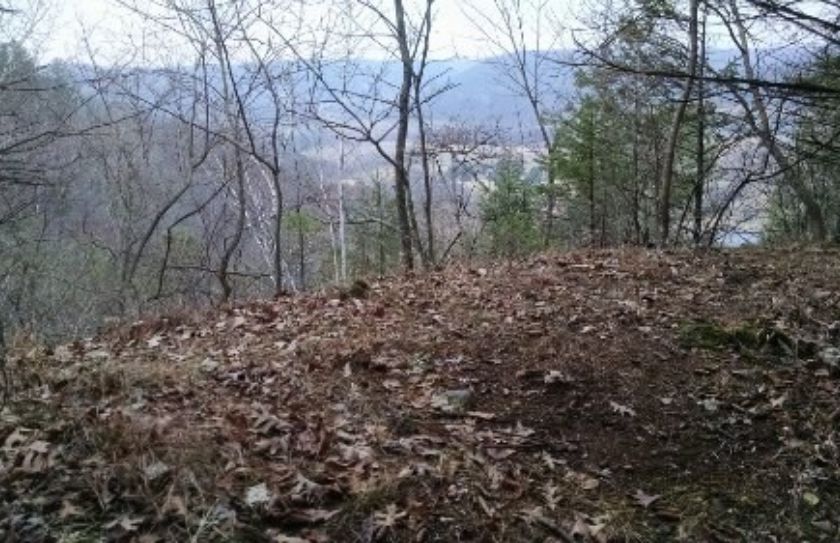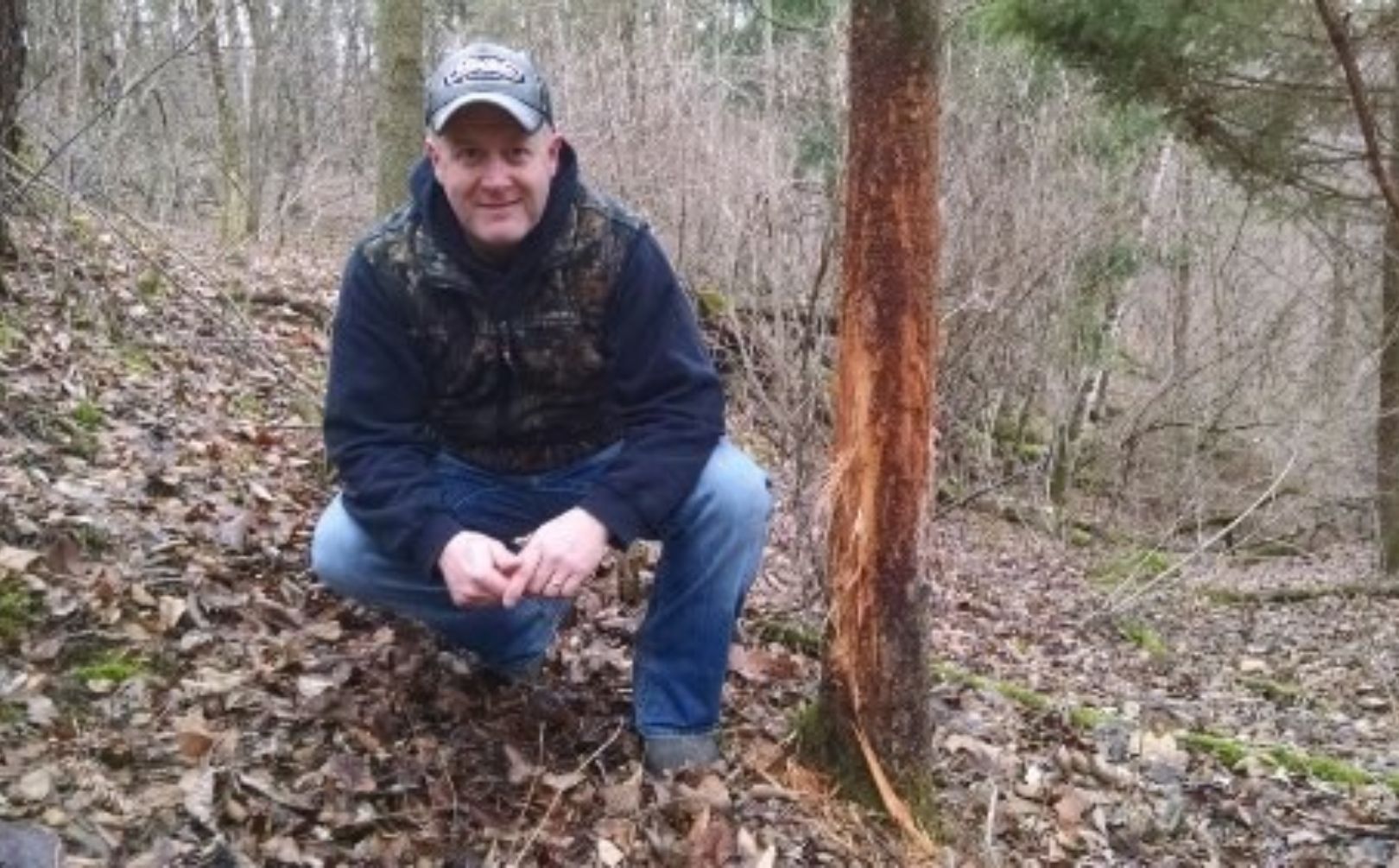
Are you firing up the chainsaw...is it that time of year? Will you be one of the 10s of thousands heading to your favorite deer woods to create daytime bedding hotspots for whitetails this year? Let the chainsaw user beware, because the correct processs of building buck beds runs much deeper than dry spots, tie-downs, hinge-cuts, canopies, level bedding platforms and high stem counts! I will touch on a few of those later, but there is a balance of deer bedding that has to be assessed on your land based on several important and often overlooked factors. "5 Rules of Building Buck Beds"...throw them out the proverbial window! And what about where a deer bed has to contain "(fill in the blank)"? I can show you many cases were it does not.
The important rule about building buck beds is that there are no rules. Instead, there are only concepts that need to be accurately recognized, balanced and applied based on the region that you hunt in, and based on the habitat that the local deer herd calls home. And exactly what habitat does the local deer herd call "home" while they retreat to their favorite honey-holes during the daylight hours? You need to find out! Because there is no substitution for accurately assessing where a local deer herd prefers to bed, other than scouting the land that you personally hunt. And if you can, it doesn't hurt to scout your neighbor's land as well, because there will be reasons that a mature buck prefers to bed in 1 location vs. another, and those reasons are the keys to the individual success on your own land.
For my career I scout deer lands (Which you can read about by clicking HERE), write about advanced habitat and hunting concepts and hunt deer full time, depending on the season. What season is it right now? It's "Scouting and Writing" season, where I am blessed to scout dozens of lands each year across an area that during the past several years has covered from New York to Delaware to Tennesse to Oklahoma to Colorado and North; and then I report back to you! I am never without my cell phone when I am scouting a client parcel or my own, and it's not because I take calls (in fact the ringer is always "off") but instead I love to take notes. As many have seen I have a "blog thoughts" area on my phone were I simply take notes when needed. That is sometimes during the dead of the night when I awake with a thought I can't wait to write about, but it is most often when I am scouting deer land. There is probably no greater single aspect of deer habitat and hunting that I like to take notes on more than when it comes to the topic of daytime bedding areas. And WOW...do the areas that mature bucks prefer vary greatly from parcel to parcel-let alone county to county, state to state or region to region. The same can be said for doe family group bedding areas too.
I often cringe when I hear that does prefer a particular type or size of deer bed that differs from what a mature buck would prefer. Why? Because the #1 concept of building buck beds is that mature bucks and doe family groups choose their bedding areas based on 3 factors:
1. Proximity to Bedding Area Stress
2. Separation of the Deer by Bedding
3. Bedding Proximity to food
That's it. If you create a "Buck Bed" in a doe bedding hotspot it will fill with does and fawns, and likewise if you create a "Doe Bed" in a buck bedding honey-hole it will be filled with bucks. It doesn't matter what size or type of bed that you build, deer choose their bedding areas based on location and stress. To say that there is one type of bed vs another as determined by sex, is to not understand the basic natural principle that you can find by scouting enough deer lands. Mature bucks and doe family groups need and choose to bed in completey different locations from one another based on the 3 factors of Stress, Separation of Each Other, and Food.
Imitating "Natural" bedding conditions is always best, and if you live in the deer woods you will find that those natural conditions again, vary greatly! Building buck beds, and more importantly deer bedding areas, is much easier than you may have been led to believe. The fictitious "5 steps to building a buck bed" may be the golden ticket in 1/3 of the deer woods...it may be viewed as indifferent in 1/3 of the habitat, and lastly those steps that were "golden" in a portion of the land could be an utter waste of time and even detrimental to your efforts in another 1/3.
*Click HERE, for an early 2011 article that I wrote about bedding areas.
I feel that my job as a professional whitetail habitat manager, deer hunter and author is to scout, take notes and report. Sharing with others has always been an incredibly enjoyable part of my career. There are no secrets in the deer woods, instead there is only truth waiting to be discovered. All of the concepts of habitat and hunting are there for those who scout, and scout often. And for those of you who are getting your saws ready but don't have the time or resources to spend the majority of the year in the deer woods across a dozen states or more experiencing what methods work in one area and not in another...this article about creating deer beds is for you!
Buck Bed Proximity to Stress
Deer are creatures of stress, and when it comes to building buck beds there is 1 critical stress related concept that you need to know: Doe family groups can take a lot more stress than a mature buck. Although you will rarely find a mature buck bedding against a field edge, backyard swale or ATV trail, that is not true when it comes to the female portion of the whitetail population. Does and their offspring have a much smaller home range than a mature buck, and it takes a lot to move them out of and away from their home stomping grounds. In fact, it often takes a complete shut-down of food sources, repeated hunting pressure, removal of adequate cover or extreme weather events to force doe family groups from their homes. So when you consider that does will tolerate a much higher stress level than a mature buck, locating and creating deer beds becomes a lot easier for you. Here are 4 principles of stress that you need to know to assess exactly where and how to build buck beds on your land.
1. Buck Bed Location
Whether you are scouting your own private land deer gem, or your next incredible public land find, it becomes easy to narrow down the locations that could possibly house a mature buck. On a 40 acre chunk surrounded by extremely active ag fields with high surrounding hunting pressure, the only area left is the middle of the parcel. However, the possible locations on most parcels of land aren't as easy as a 40 acre chunk of ground surrounded by stress. Low impact wooded neighbors, adjacent high stress "people areas" of neighborhoods, businesses or parks and remote public land settings all have their influence but rest assured, if it's the location of the lowest stress on your land, it is your best bet for a mature buck bedding hotspot.
2. High Deer Numbers = Bedding Stress
The higher the population, the more tolerant both sexes are of various stressors. What does this mean to you? It means the that you can pack a whole lot more deer into 20 acres of cover in a high deer population, high % ag land area, then you can a remote wilderness parcel.
3. Habitat Too Thick For Bedding, or Not Thick Enough?
Have you ever heard "It can't be too thick" when it comes to building buck beds? Well, it can...and it's pretty easy to do so! Yes, in a Northern OH or Central IL coverless ag location thicker is always better, but when it comes to the majority of parcels across the whitetail range deer appreciate some space. A good thought to keep in mind is that deer are forced into extremely heavy cover when the population is high and the acres of available cover is low, however they choose to be located within cover that offers the balance of space appropriate for their area, when they can. What is appropriate for a given area? Well, here are some general guidelines:
*Remote high cover, low deer population areas dictate large and open bedding areas. Below is a picture of an outstanding bedding area most likely taken over by 1 mature buck, within a vast, high cover, low deer population Southern OH public land area. A buck located in this area is impossible to approach from 100 yards away or more from almost any direction, yet he is afforded the luxury of a higher stem count per acre than most of the area, adjacent blowdowns, and a large level, dry surface. In hill country, a bedding area like this is outstanding whether located high or low, but as you can see "open" is the rule in this type of setting. Construted canopies and heavy hinge cuttings that force whitetails to squeeze and crawl into tight quarters will often be completely avoided by deer in these areas.
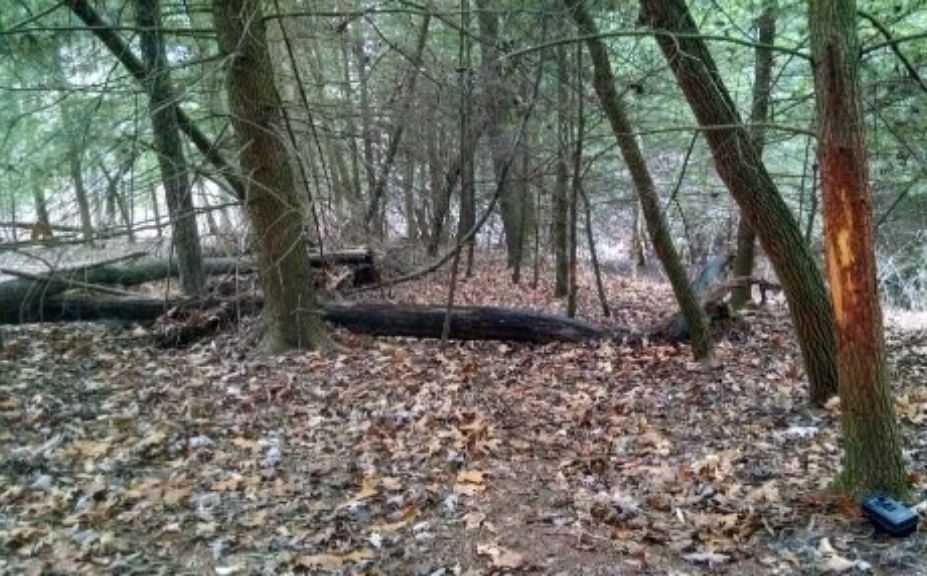
*Moderate cover and population #s consistent with the majority of whitetail habitats across much of the country dictate balance. A general rule is that if you can drive an ATV through a constructed bedding area, with a few tight turns here and there, you are approaching the correct balance. Deer in these areas prefer NOT to have to crawl, squeeze, jump and dive through their daytime security areas. Also, a deer in these areas still like to be able to see for a distance while bedded. Is that distance 10 yards, 20 yards, or 30 yards? There are a host of population and habitat balances that come into play, but there are 2 things for sure: A site-line of 10' is too short, and 50 yards is too far. Constructed canopies created by hinge cuttings and tie-downs of 1" saplings or less can be useful, but are not necessary to attract or hold deer in these areas. At the same time, if the canopy caves in...the entire bedding area can be compromised because of a limited # of Pass-Thrus, which will be discussed in a bit.
*Low cover, high population areas are where the deer allow you to become a little more creative while building deer beds. Will a deer crawl, squeeze, jump and dive into cover if they are forced to? They sure will (only in these areas), and creating extremely compartmentalized bedding areas that allow for the separation of deer within, is definitely called for.
*In general for any bedding area construction, when the number of "Dead Ends" exceeds the number of "Pass-Thrus" then a deer will often avoid the area. Deer need to be able to escape, and if at any wrong turn another dead-end is evident, then they will avoid the entire area of cuttings, deer beds or habitat that you have created. A great example of this are the many 5-10 acre cuttings I have witnessed across various states that have very few exits for the deer that are trying to be attracted within. A random trail here or there that crosses through a cutting is just not enough to attract and hold deer. Instead, I prefer to see "never-ending" deer trails that create virtually a grid-pattern of a maze that allows deer to move in or out at any turn. Have you ever visited a deer yarding area within conifer lowlands? The reason deer can so easily escape predators in areas like this is because of the complete maze of packed down deer trails throughout the deer yard. Deer can escape at any turn, and they can twist, escape and confuse any predator that pursues! Your bedding areas should be the same...no matter if you live in a remote wilderness setting, or a high-ag low cover setting. "Natural" should always be mimicked! The great risk of creating a patchwork of canopied bedding areas is that with 1 caved in structure, you have the potential to block-off and disrupt the natural flow through an entire bedding area. Closed off, dead-end bedding area = high stress, and whether you are attempting to house bucks or does, a high level of stress is completely detrimental to your efforts...even if it includes all of the "proper" steps for building buck beds. In some situations, the potential high risks of creating canopied buck beds is not worth the low value of the rewards; it pays to assess, recognize and understand why.
4. Canopied Buck Bed Locations?
How important are canopies when it comes to building buck beds? Not very. For one thing, if you have ever had the opportunity to experience dozens of known, natural mature buck bedding areas you will find that rarely do they offer a canopy. Exposed rocky points surrounded by briars, mini-raised islands surrounded by cattails and hardwood regen areas are just 3 of the natural, high quality buck bedding areas that lack canopies. Have you personally ever discovered a mature buck bedding area without a canopy? But, I like to offer this analogy for further thought:
*Imagine that there is a small grove of medium-aged hardwood species that measures 20' x 20' in the middle of a 160 acre hay field. I know...any land-owner would have ripped that little habitat nugget out for farming efficiency, but please bear with me! Now, let say that you use that timber to hing inward and create an incredible, 20' x 20' canopy. Pretty cool right? Well considering that you used all of the trees to form the canopy and you can still see the fencerow on the opposite side of the field, 1/2 mile from where you are standing..."not so much". And even if you leave a few scattered logs within the canopy area so a deer has something to relate to when bedding, deer still won't use the bedding area.
***on a side note, when deer need to use those logs within a deer bed it's because there is not enough surrounding cover to relate to...so the log is the only thing that will attract them to the bed and is evidence of an overall bedding area that lacks sufficient cover***
For the next part of this analogy imagine using the outside 5' of width of that 20' x 20' pocket of timber to cut, and hinged outward away from the center while creating zero canopy. You now can't see into the proposed bedding area, and deer can't see out. NOW it is a bedding area...canopy, or not. If you were to create a bedding area like this, it would most definitely house deer.
Although I do believe that a canopy can help you capture that last few % points of attraction when building buck beds, the canopy itself is one of the least important aspects of the entire process. Why is there so much importance placed on the act of creating canopies when building buck beds? Because in the act of creating those cool looking canopies the critical components of side cover and regeneration are often adequately addressed. And when you locate low-stress cuttings where a mature buck should bed, great things can happen.
I will repeat this often, but when you are building buck beds, creating a canopy is the least important step. Creating a canopy also makes my Top 10 Habitat Management Myths, not because it doesn't work in some areas, but because it isn't effective in many. In fact in my experience while building buck beds, creating deer areas and teaching over 500 landowners across 19 states how to create bedding hotspots that fit their land; a canopy shouldn't even be a part of the process for most habitats.
In general, To say there is one type of deer bed that works in all locations, would be to imply that all whitetail habitats and deer herds are the same. That just isn't the case or it would make my job a whole lot easier.
Separation of Deer By Bedding Area
Making sure that bucks and does bed separately from on another could have easily been discussed under the topic of "Stress"! Because when it comes to building buck beds, or bedding areas in general, the aspect of stress dictates completely different bedding locations for each sex. But at the same time this is such an important topic in itself as it relates to keeping not only bucks and does bedding away from each other, but by allowing for enough separation for bucks to bed away from other bucks, and doe family groups to bed an adequate distance away from each other. The balance of the habitat and overall number of deer will dictate the distance deer prefer to bed away from each other. When the population numbers of deer increases, and the amount of available acres of cover decreases, the closer the proximity that deer will tolerate the presence of each other.
The size and distance of separation between bedding areas vary greatly from region to region. Bedding areas are simply a collection of travel corridors and bedding pockets that cover a given area. Rarely does it pay to create 1 deer bed, because often in doing so you do not have enough supporting cover to help hide and house the particular deer that would occupy that bed. It is possibly that an entire 40 acre clearcut may not be enough to house 1 mature buck in an extremely remote wilderness setting while on the otherhand an area the size of a small garage could possibly attract the oldest buck in the neighborhood, in the right location, in a high population ag setting with limited cover. What's the difference? In remote wilderness settings deer have many choices for potential bedding opportunities, but in low cover ag areas they do not. Successful low-cover ag bedding area creations can offer extremely deceiving conclusions, because you are observing deer that are often forced into bedding areas because they have very few other bedding options. Then, when you apply those same tactics to more typical whitetail habitats they can often then be viewed as a detriment to the land, habitat and herd.
As in most habitat improvements, balance is still key to your success! In the typical mixed ag and cover region across the range of whitetails, a distance of 50 yards separating 1/4 to 1/2 acre bedding areas is a great general guide to use when planning your property design. However, in low cover areas it is possible to stack deer nearly 1 on top of the other if they are separated by adequate screenings of grass, cuttings or conifer. On the other hand, I have personally known of mature bucks in wilderness settings that preferred to bed hundreds of yards away from established doe family groups that were directly relating to an adjacent major food source, even though they passed many high quality bedding opportunities to do so! The reason they most likely chose to do so? Because they had enough space and unpressured quality cover to separate themselves to the natural distances that they most likely preferred.
Bedding Proximity to Food
You have probably seen me write this often, but the fact that deer feed 5Xs per day is not only a critical concept when it comes to advanced hunting strategies, but when it comes to building buck beds as well. Food dictates exactly where you should begin your bed building efforts and what type of habitat components should be used to create quality bedding areas.
1. Bedding opportunity beginswith FOOD!
Food is an extremely powerful tool as it relates to where and how you should create your bedding areas. Given that doe family groups can tolerate a much higher level of stress, and also prefer a much smaller home range than mature bucks, it pays to use food to locate doe family groups. Major food sources of a 1/2 acre or more in size such as a consistent hunting season-long food plot, will create the potential for preferred doe bedding areas nearby. Doe you have a problem with random deer movements across the lands that you hunt? Try making sure that you match the size of the bedding area to your region, and then build a bedding area adjacent to a major food source. Definition of deer movement starts by making sure that there is adequate doe bedding opportunity directly adjacent to major evening destination food sources. For populations of 12-15 does and fawns or more, 4-5 bedding areas of a 1/2 acre or more in size should be adequate to house the number antlerless deer close to their food source. What that does is to allow you to pull does away from the majority of your land, and to define exactly where they are bedding adjacent to the food source. By keeping hunting pressure virtually non-existent around the food source, you can expect a tight window of doe family group bedding to food source movement in a limited amount of space on your land. You can offer additional layers of similar bedding sizes into your land even deeper if more room is required, but at some point you will eventually create enough additional space for mature bucks to bed behind the doe family groups, and away from the food. In light cover areas the movement of mature buck bedding to a major food source could be 200 yards or less as deer are forced to be sandwiched between close layers of cover. On the other hand that movement could be a mile or more in remote high-cover wilderness regions where deer are allowed to utalize all of the space that they naturally desire.
2. Buck Beds and Food Sources
Switchgrass (SG), is the most overrated bedding component used today. But please hear me out. If you are able to grow it based on the growing conditions in your area, SG is a planting that can be used as a great contribution to your overall deer habitat plan on just about any parcel. Does that sound like I am contradicting myself? Again...please hear me out!
SG is an oustanding cover feature...that also features no food. However when SG is used as a base cover in combination with natural regen, conifers, shrubs, weeds and briars, it can be a great component, especially in small pockets. Deer need to feed at least twice during the daytime hours so if you are expecting to hold deer in SG all day (or solid spruce and pines too!), then those same deer will have to miss feedings unless they can leave the SG to browse and return to their bedding areas. And that's why in small plantings of a 1/2 acre or less, SG can be an outstanding cover option.
Being able to hold deer in large SG plantings is actually a real possibility in low cover high % ag areas, but it is not at all practical in the average setting and especially the closer you travel towards remote high cover areas. The process of creating hinge cut bedding areas and regeneration in hardwood settings produces a great amount of mid-quality browse that deer can enjoy all-day long. At the same time the mid-range browse created by building buck beds does not compare in quality to the evening destination food sources that you can use to establish adjacent doe family group bedding. That separation in the quality of food located in daytime bedding areas and evening destination food sources is critical because it forces deer to move.
I have been able to witness many times over that deer will completely avoid SG plantings of a few acres or more in favor of hardwood regen and other locations that offer natural browsing sources of lowland shrubs, mast cropss, and briars. Often when you find large #s of deer residing in SG bedding areas during the day, it is because they are forced into those locations due to the lack of unpressured quality cover alternatives that features natural browse or regeneration. And the same could be said for solid stands of conifer as well! In order to build buck beds, you have to have an adequate nearby food source, in particular hardwood regen.
SG also carries a predator factor as well. A wolf can circle downwind of an SG field of moderate size and virtually pinpoint every deer within that space of cover. Those deer are pretty easy to pick off with a slow, quiet approach and I believe that fact is hardwired into their well-tuned instincts as a major prey species. Deer seem to be at complete ease traveling through SG into an adjacent food source during the daylight hours, but extremely reluctant to actually spend an entire day in the SG unless forced to, with the exception of Summer fawning grounds.
Conclusion
The picture below is the same rub as in the picture at the beginning of this article. Bedding areas come in all shapes and sizes, but when you learn to accurately read and locate the appropriate buck bedding areas for the lands that you hunt, a great amount of whitetail success is there for the taking; whether you are building the buck beds on the land, or not.
Is the process of building buck beds a mystery? No way, but I have made many mistakes along the way attempting to figure it out. It has been a pure luxury to not only be able to scout deer bedding areas many years after I personally created them, but after others have created them as well. I have learned more by experiencing the mistakes of myself and others, than by following a strict set of rules. After scouting bedding areas in nearly 20 states, and in nearly every deer habitat imaginable, I have experienced the process of building buck beds should be seen as varied as the lands and herds themselves. There have been literally dozens of man-made bedding areas completely devoid of deer on landowner parcels throughout the years! But while exploring the reasons why with landowners, those unused deer beds presented not only great opportunities to learn, but to then accurately make adjustments to recreate those same bedding areas.
As long as you give deer room to move about the cuttings or plantings that you create, allow for a separation from each other as well as each sex, and effectively use the power of food in your habitat or hunting designs you are most of the way there! The greatest mystery of all however, most likely needs to revolve around the fact that there is actually no set of rules or practices that will successfully allow you to build a buck bed on the majority of lands across the entire whitetail range. There is no set of rules for building buck beds that applies to the majority of whitetail habitats across the country. I encourage you to scout as many deer acres as you can, as often as you can! As in food, water and hunting methods, Balance needs to be assessed, experienced and accurately defined before you ever even fire up the saw to begin building buck beds.
